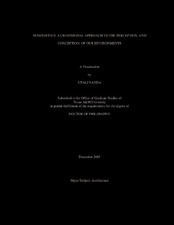| dc.description.abstract | This dissertation counters the visual bias, and the simplistic approach to the
senses, in architectural thought, by investigating the connections among different sense
modalities (sight, sound, smell, taste and touch). Literature from the cognitive sciences
shows that sensory modalities are connected perceptually; what we see affects what we
hear, what we smell affects what we taste, and so on. This has a direct impact on the
perceptual choices we make in our day-to-day lives.
A case study conducted in an urban plaza investigates the perceptual choices
people make (or what they attend to) as they explore their physical environment.
Results show that people construct subjective and embodied mental maps of their
environments where sensory impressions are integrated with cognitive concepts such as
emotions or object recognition. Furthermore, when one sense is muted (such as closing
the eyes) other senses are prioritized. A theoretical framework termed as the "Sensthetic Model" is developed illustrating the interdependence of sensory, kinesthetic and cognitive factors, and the hierarchical and lateral relationship between sense-modalities.
The latter is the focus of studies with architecture students in abstract thinking exercises:
a) Hierarchical: Students perceive a hierarchy of senses (sensory order) when
they think about different places. Vision is primary, but not always. Touch, classically
relegated to the bottom of the hierarchy, is often higher in the hierarchy and coupled
with sound.
b) Lateral: Students associate colors with different sounds, smells, textures,
temperatures, emotions and objects and cross over modalities conceptually, with a
degree of consistency. There are more associations with emotions and objects (which are
not constrained to a single sense-modality), than with purely sensory images.
Finally, the theoretical model is further developed as a tool to think
"across" modalities (crossmodally) based on the identification of sensory orders and
sensory correspondences. By focusing on the sensory modalities (nodes) and the
relationships among them (connections), the model serves as a conceptual tool for
professionals to create sensory environments. This dissertation is an initial step beyond
the aesthetics of appearance, towards the Sensthetics of experience. | en |


